![]()
![]()
![]()
Use LEFT and RIGHT arrow keys to navigate between flashcards;
Use UP and DOWN arrow keys to flip the card;
H to show hint;
A reads text to speech;
254 Cards in this Set
- Front
- Back
|
What are the three macro-units of the cardiovascular system.
|
The human cardiovascular system is composed of a muscular four-chambered heart, a network of blood vessels, and the blood itself.
|
|
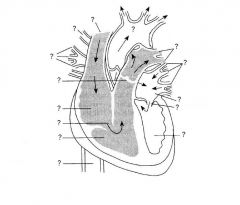
|

|
|
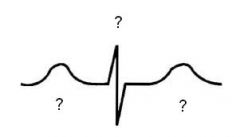
|

|
|

|

|
|
|
What is the purpose of a cardiovascular system?
|
To transport repiratory gases, nutients, and wastes to and from cells.
|
|
|
What is the secondary circulatory system known as?
|
The lymphatic system
|
|
|
What does the lymphatic system do?
|
Collects excess body fluids and returns them to the cardiovascular circulation
|
|
|
What are the three components of the cardiovascular system?
|
Heart, blood vessels and blood
|
|
|
What side of the heart pumps deoxygenated blood into the lungs?
|
The right side of the heart
|
|
|
What side of the heart recieves blood from the lungs?
|
The left side
|
|
|
Blood returning from the lower body and extremities enters the heart via the ________.
|
Inferior Vena Cava
|
|
|
Deoxygenated blood from the upper head and neck region flows through the __________ and into the _________.
|
Jugular Vein & Superior Vena Cava
|
|
|
Oxygenated blood is supplied to the heart muscule by the _______.
|
Coronary Arteries
|
|
|
How many portal systems are there in the body?
|
3
|
|
|
Where are the three portal systems of the body located?
|
Liver, kidneys and brain
|
|
|
What is the name of the liver portal system?
|
hepatic portal circulation
|
|
|
What is the name of the brain portal system?
|
hypophyseal portal circulation
|
|
|
What are the two upper chambers of the heart known as?
|
Atria
|
|
|
What are the two lower chambers of the heart known as?
|
ventricles
|
|
|
Where is the location of the AV valves?
|
Between the Atria and the Ventricles
|
|
|
What is the pupose of the AV valves?
|
Prevent backflow of blood into the atria
|
|
|
What is another name for the right AV valve?
|
tricuspid
|
|
|
What is another name for the left AV valve?
|
mitral
|
|
|
Where are the names of the two semilunar valves?
|
aortic and pulminary
|
|
|
How many valves are in the heart?
|
Four (two semi lunar - two AV valves)
|
|
|
What period is systole?
|
Period in which the ventricles contract
|
|
|
What period is diastole?
|
Period in which the cardiac muscules relax
|
|
|
What is cardiac output defined as?
|
heart rate x stroke volume
|
|
|
What is the first heart sound ("lub" or "S1") caused by?
|
When two AV valves close at the start of systole
|
|
|
What is the second heart sound ("dub" or "S2") caused by?
|
When two semilunar valves close at the conclusion of systole
|
|
|
What node is also known as the pacemaker?
|
The SA node
|
|
|
What node in the heart is most superior?
|
The SA node
|
|
|
What is the electrical conduction route in the heart?
|
SA node -> AV node -> Purkinje fibers
|
|
|
What is the name of the fibers that split the electrical impules to two sides of the heart?
|
Purkinje Fibers
|
|
|
What nervous system modifies the rate of heart contraction?
|
ANS (autobomic)
|
|
|
The heart is innervated by what nerve of the parasympathetic system?
|
Vagus Nerve
|
|
|
The heart is innervated by what nerve of the sympathetic system?
|
Cervical and Thoracic Ganglia
|
|
|
What part of the body secretes epinephrine to increase heart rate?
|
Adrenal Medula
|
|
|
What are the three blood vessels types and their stuctures?
|
Arteries= thick walled, muscular, elastic ; Veins= Thin walled inelastic with backflow valves ; Capillaries= Thin walls composed of endothelial cells.
|
|
|
What is blood pressure defined as?
|
Force per area that blood exerts on the walls of the blood vesselse
|
|
|
What happens to blood pressure along it's circulitory route?
|
It drops
|
|
|
On average the human body contains how many liters of blood?
|
4-6L
|
|
|
What is the percentage of liquid components in blood?
|
55%
|
|
|
What is the percentage of cellular components in blood?
|
45%
|
|
|
What is plasma and what does it consist of?
|
The liquid portion of blood, anything that is not a blood cell. ie. nutrients, salts, respiratory gases, wastes, hormones etc.
|
|
|
What are the three major components of the cellular composition of blood?
|
erythrocytes, leukocytes and platelets
|
|
|
What are erythrocytes also known as?
|
Red blood cells
|
|
|
How many molecules of hemoglobin make up a red blood cell?
|
250 million
|
|
|
Each hemoglobin can bind to how many molecules of oxygen?
|
4 molecules of oxygen
|
|
|
What advantage does the biconcave disk shape of red blood cells have?
|
Increased surface area for gas exchange
|
|
|
Where do erythrocytes originate from?
|
Bone marrow
|
|
|
For how many days do red blood cells circulate?
|
120 days
|
|
|
What do red blood cells lack?
|
Mitochondia and memranous organelles
|
|
|
How many red blood cells are there for every mm^3 of blood?
|
5 million
|
|
|
What is the general function of Leukocytes?
|
Protection
|
|
|
Normally how many leukocytes can you find in one mm^3 of blood?
|
5-10k
|
|
|
Where do Leukocytes originate from?
|
Stem cells in the marrow of long bones
|
|
|
What are the two types of leukocytes?
|
Granulocytes and Agranulocytes
|
|
|
What are the three types of Granulocytes?
|
Neutrophils, Basophils and Eosinophils
|
|
|
What is the main role of granular leukocytes?
|
Inflammation, Allergic Reactions, Pus Formation and destruction of Invading Bacteria and Parasites
|
|
|
What do lymphocytes play a role in?
|
Production of antibodies
|
|
|
What are the two types of lymphocytes?
|
B and T lympocytes
|
|
|
What do monocytes do?
|
Phagocytize foreign matter and orginisms such as bacteria
|
|
|
Monocytes that migrate into the tissue from blood and mature are known as...
|
Macrophages
|
|
|
What can macrophages do better than monocytes?
|
They have a greater pagocytic capability
|
|
|
How big are platelets?
|
2-3 micrometers in diameter
|
|
|
Where are platelets formed?
|
In the bone marrow
|
|
|
What basic cell structure do platlets lack?
|
A nuclei
|
|
|
How many platelets are in one mm^3 of blood
|
250-500 thousand
|
|
|
What is another term used for cell-surface proteins?
|
Antigens
|
|
|
What are the two major groups or red blood cell antigens?
|
ABO group and Rh factor
|
|
|
What are the four ABO groups?
|
A, B, O and AB
|
|
|
If you have type A blood, what antigen do you have? What antibodies do you have?
|
Antigen A w/ anti-B antibodies
|
|
|
If you have type B blood, what antigen do you have? What antibodies do you have?
|
Antigen B w/ anti-A antibodies
|
|
|
If you have type AB blood, what antigen do you have? What antibodies do you have?
|
Antigen A&B w/ no A or B antibodies
|
|
|
If you have type O blood, what antigen do you have? What antibodies do you have?
|
No A or B Antigen w/ anti-A and anti-B antibodies
|
|
|
What is the fear of not correctly blood typing when it comes to blood transfusions?
|
That the transfused blood will clump with the antigens in the recipients blood.
|
|
|
Who is the universal recipient?
|
AB blood
|
|
|
Who is the universal donor?
|
O
|
|
|
What are the two types of RH factors that someone might have?
|
+ or -
|
|
|
What is the danger with the RH factor when giving birth?
|
The Rh factor is another antigen that may be present on the surface of red blood cells. Individuals may be Rh+, possessing the Rh antigen, or Rh-, lacking the Rh antigen. Consideration of the Rh factor is particularly important during pregnancy. An Rh- woman can be sensitized by an Rh+ fetus if fetal red blood cells (which will have the Rh factor) enter maternal circulation during birth. If this woman subsequently carries another Rh+ fetus, the anti-Rh antibodies she produced when sensitized by the first birth may cross the placenta and destroy fetal red blood cells. This results in a severe anemia for the fetus, known as erythroblastosis fetalis. Erythroblastosis is not caused by ABO blood-type mismatches between mother and fetus, since anti-A and anti-B antibodies cannot cross the placenta.
|
|
|
What does a hemoglobin molecule consist of?
|
Four polypeptide chains
|
|
|
What is is that the hemoglobin actually has that binds to a molecule of oxygen?
|
A heme group (polypeptide chain)
|
|
|
What occurs after the first of four hemes attaches to an oxygen?
|
The O2 induces a chemical change that changes the confirmation of the other heme groups and allows them to bind more easily.
|
|
|
What is the Bohr effect?
|
Increasing concentrations of H+ (a decrease in pH) and CO 2 (an increase in HC0 3-) in the blood decrease hemoglobin's 02 affinity. Thus, the presence of high concentrations of H+ and CO 2 in metabolically active tissue, such as muscle, enhances the release of O 2 to this tissue.
|
|
|
Both formation of and dissociation of carbonic acid are catalyzed by what enzyme?
|
Carbonic Anhydrase
|
|
|
Through what atonomical features are amino acids and sugars absorbed?
|
Through the intestinal capillaries
|
|
|
Where do the intestinal capillaries carry the nutrients?
|
To the liver through the hepatic portal
|
|
|
What is hydrostatic pressure?
|
Hydrostatic pressure is the pressure exerted by the heart on the blood. It causes the blood to move out to the cells.
|
|
|
What is osmotic pressure?
|
Osmotic pressure is the pressure exerted through the greater concentration of solutes in the blood than in the cells. It causes the fluids to travel from the cells into the blood.
|
|
|
What is the hydrostatic pressure of blood in the capillaries?
|
15-30 mmHg
|
|
|
What is formed at the sight of a damaged vessel?
|
Platlet plug
|
|
|
What do the platlets and the clotting factor release in order to make the platlet plug?
|
Thromboplastin
|
|
|
What specifically does thromboplastin do?
|
Converts the inactive fibrinogen into into fibrin with the help of calcium and vitamin K.
|
|
|
What does fibrin do?
|
It traps blood cells to form a clot
|
|
|
What causes Haemophilia (spelling in all places apart from North America)?
|
A lack of one of the clotting factors
|
|
|
What are the two major defense mechanisms of the immune system?
|
Humoral Immunity and Cell-mediated Immunity
|
|
|
What is Hummoral Immunity characterised by?
|
Production of antibodies
|
|
|
What is Cell-mediated immunity characterized?
|
Involves cells that combat fungal and viral infections
|
|
|
What is another term for antibodies?
|
Immunoglobulins
|
|
|
What is the specific ability and function of antibodies?
|
Humoral immunity is responsible for the proliferation of antibodies following exposure to antigens. Antibodies, also called immunoglobulins (Igs), are complex proteins that recognize and bind to specific antigens and trigger the immune system to remove them. Antibodies either attract other cells (such as leukocytes) to phagocytize the antigen, or cause the antigens to clump together (agglutinate) and form large insoluble complexes, facilitating their removal by phagocytic cells.
|
|
|
What is the specific structure of Antibodies?
|
An antibody molecule consists of four polypeptide chains-two identical heavy chains and two identical light chains-held together by disulfide linkages and noncovalent bonds. Certain regions on the chains (called variable regions) serve as antigen-binding sites; these sites are structured so as to bind to one specific antigen. The remaining part of the chains (the constant regions) aid in the process by which foreign antigens are destroyed
|
|
|
On antibodies how many different categories of variable regions exist? What are they?
|
There are five types of constant regions - M, A, D, G, and E - defining five classes of immunoglobulins: IgM, IgA, IgD, IgG, and IgE.
|
|
|
What lymphocytes are active in the humoral response?
|
B lymphocytes
|
|
|
How do B lymphocytes become specific for a particular antigen?
|
When exposed to a specific antigen, B lymphocytes specific for that antigen proliferate.
|
|
|
What are the two things that the daughter cells of B lympocytes become?
|
Memory cells and plasma cells
|
|
|
What is the primary immunilogical response?
|
The immune response occurring on the first exposure to a foreign material in the body.
|
|
|
What is the secondary immunilogical response?
|
The immune response which occurs on second or repeated exposure to a foreign material for which antibodies have already been created.
|
|
|
What is active immunity?
|
Production of antibodies during an immune response
|
|
|
What is passive immunity?
|
The passage of antibodies which were created by another individule or organism.
|
|
|
What lasts longer, passive or active immunity?
|
Active immunity causes the mechanisms which create the antibodies to be created in the body and always make antibodies, therefore active immunity lasts longer than the temporary passive immunity.
|
|
|
What are the lymphocytes which are involved in cell-mediated immunity known as?
|
T lymphocytes
|
|
|
What is another name for T lymphocytes?
|
T cells
|
|
|
Where do the T cells originate from?
|
The bone marrow
|
|
|
What do the T cells primarily work against?
|
The body's own cells that are infected by fungus or a virus
|
|
|
What T cells destroy antigens?
|
cytotoxic T cells
|
|
|
What T cells activate other B and T cells?
|
Helper T cells
|
|
|
What do supressor T cells do?
|
Regulate B and T cells to decrease their activity against antigens.
|
|
|
What common things can act as antigens and cause the stimulation of a histamine response?
|
Pollen or certain foods
|
|
|
What are the types of diseases known as that cause the body to reject its own cells?
|
Autoimmune disease
|
|
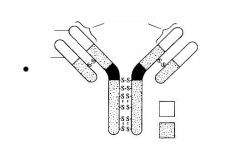
|

|
|

|

|
|

|

|
|
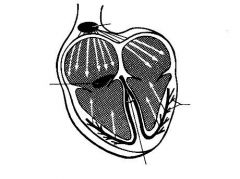
|

|
|
|
will use later
|
will use later
|
|

|
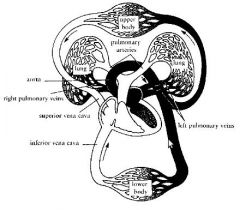
|
|
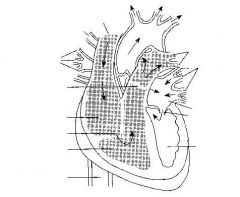
|

|
|
|
What are the three macro–units of the cardiovascular system.
|
The human cardiovascular system is composed of a muscular four–chambered heart, a network of blood vessels, and the blood itself.
|
|
|
//fce-study.netdna-ssl.com/images/upload-flashcards/front/4/4/25144366_m.jpg
|
//fce-study.netdna-ssl.com/images/upload-flashcards/back/4/4/25144366_m.jpg
|
|
|
//fce-study.netdna-ssl.com/images/upload-flashcards/front/4/4/25144387_m.jpg
|
//fce-study.netdna-ssl.com/images/upload-flashcards/back/4/4/25144387_m.jpg
|
|
|
//fce-study.netdna-ssl.com/images/upload-flashcards/front/4/4/25144417_m.jpg
|
//fce-study.netdna-ssl.com/images/upload-flashcards/back/4/4/25144417_m.jpg
|
|
|
What is the purpose of a cardiovascular system?
|
To transport repiratory gases, nutients, and wastes to and from cells.
|
|
|
What is the secondary circulatory system known as?
|
The lymphatic system
|
|
|
What does the lymphatic system do?
|
Collects excess body fluids and returns them to the cardiovascular circulation
|
|
|
What are the three components of the cardiovascular system?
|
Heart, blood vessels and blood
|
|
|
What side of the heart pumps deoxygenated blood into the lungs?
|
The right side of the heart
|
|
|
What side of the heart recieves blood from the lungs?
|
The left side
|
|
|
Blood returning from the lower body and extremities enters the heart via the ________.
|
Inferior Vena Cava
|
|
|
Deoxygenated blood from the upper head and neck region flows through the __________ and into the _________.
|
Jugular Vein & Superior Vena Cava
|
|
|
Oxygenated blood is supplied to the heart muscule by the _______.
|
Coronary Arteries
|
|
|
How many portal systems are there in the body?
|
3
|
|
|
Where are the three portal systems of the body located?
|
Liver, kidneys and brain
|
|
|
What is the name of the liver portal system?
|
hepatic portal circulation
|
|
|
What is the name of the brain portal system?
|
hypophyseal portal circulation
|
|
|
What are the two upper chambers of the heart known as?
|
Atria
|
|
|
What are the two lower chambers of the heart known as?
|
ventricles
|
|
|
Where is the location of the AV valves?
|
Between the Atria and the Ventricles
|
|
|
What is the pupose of the AV valves?
|
Prevent backflow of blood into the atria
|
|
|
What is another name for the right AV valve?
|
tricuspid
|
|
|
What is another name for the left AV valve?
|
mitral
|
|
|
Where are the names of the two semilunar valves?
|
aortic and pulminary
|
|
|
How many valves are in the heart?
|
Four (two semi lunar – two AV valves)
|
|
|
What period is systole?
|
Period in which the ventricles contract
|
|
|
What period is diastole?
|
Period in which the cardiac muscules relax
|
|
|
What is cardiac output defined as?
|
heart rate x stroke volume
|
|
|
What is the first heart sound ("lub" or "S1") caused by?
|
When two AV valves close at the start of systole
|
|
|
What is the second heart sound ("dub" or "S2") caused by?
|
When two semilunar valves close at the conclusion of systole
|
|
|
What node is also known as the pacemaker?
|
The SA node
|
|
|
What node in the heart is most superior?
|
The SA node
|
|
|
What is the electrical conduction route in the heart?
|
SA node –> AV node –> Purkinje fibers
|
|
|
What is the name of the fibers that split the electrical impules to two sides of the heart?
|
Purkinje Fibers
|
|
|
What nervous system modifies the rate of heart contraction?
|
ANS (autobomic)
|
|
|
The heart is innervated by what nerve of the parasympathetic system?
|
Vagus Nerve
|
|
|
The heart is innervated by what nerve of the sympathetic system?
|
Cervical and Thoracic Ganglia
|
|
|
What part of the body secretes epinephrine to increase heart rate?
|
Adrenal Medula
|
|
|
What are the three blood vessels types and their stuctures?
|
Arteries= thick walled, muscular, elastic ; Veins= Thin walled inelastic with backflow valves ; Capillaries= Thin walls composed of endothelial cells.
|
|
|
What is blood pressure defined as?
|
Force per area that blood exerts on the walls of the blood vesselse
|
|
|
What happens to blood pressure along it's circulitory route?
|
It drops
|
|
|
On average the human body contains how many liters of blood?
|
4–6L
|
|
|
What is the percentage of liquid components in blood?
|
55%
|
|
|
What is the percentage of cellular components in blood?
|
45%
|
|
|
What is plasma and what does it consist of?
|
The liquid portion of blood, anything that is not a blood cell. ie. nutrients, salts, respiratory gases, wastes, hormones etc.
|
|
|
What are the three major components of the cellular composition of blood?
|
erythrocytes, leukocytes and platelets
|
|
|
What are erythrocytes also known as?
|
Red blood cells
|
|
|
How many molecules of hemoglobin make up a red blood cell?
|
250 million
|
|
|
Each hemoglobin can bind to how many molecules of oxygen?
|
4 molecules of oxygen
|
|
|
What advantage does the biconcave disk shape of red blood cells have?
|
Increased surface area for gas exchange
|
|
|
Where do erythrocytes originate from?
|
Bone marrow
|
|
|
For how many days do red blood cells circulate?
|
120 days
|
|
|
What do red blood cells lack?
|
Mitochondia and memranous organelles
|
|
|
How many red blood cells are there for every mm^3 of blood?
|
5 million
|
|
|
What is the general function of Leukocytes?
|
Protection
|
|
|
Normally how many leukocytes can you find in one mm^3 of blood?
|
5–10k
|
|
|
Where do Leukocytes originate from?
|
Stem cells in the marrow of long bones
|
|
|
What are the two types of leukocytes?
|
Granulocytes and Agranulocytes
|
|
|
What are the three types of Granulocytes?
|
Neutrophils, Basophils and Eosinophils
|
|
|
What is the main role of granular leukocytes?
|
Inflammation, Allergic Reactions, Pus Formation and destruction of Invading Bacteria and Parasites
|
|
|
What do lymphocytes play a role in?
|
Production of antibodies
|
|
|
What are the two types of lymphocytes?
|
B and T lympocytes
|
|
|
What do monocytes do?
|
Phagocytize foreign matter and orginisms such as bacteria
|
|
|
Monocytes that migrate into the tissue from blood and mature are known as...
|
Macrophages
|
|
|
What can macrophages do better than monocytes?
|
They have a greater pagocytic capability
|
|
|
How big are platelets?
|
2–3 micrometers in diameter
|
|
|
Where are platelets formed?
|
In the bone marrow
|
|
|
What basic cell structure do platlets lack?
|
A nuclei
|
|
|
How many platelets are in one mm^3 of blood
|
250–500 thousand
|
|
|
What is another term used for cell–surface proteins?
|
Antigens
|
|
|
What are the two major groups or red blood cell antigens?
|
ABO group and Rh factor
|
|
|
What are the four ABO groups?
|
A, B, O and AB
|
|
|
If you have type A blood, what antigen do you have? What antibodies do you have?
|
Antigen A w/ anti–B antibodies
|
|
|
If you have type B blood, what antigen do you have? What antibodies do you have?
|
Antigen B w/ anti–A antibodies
|
|
|
If you have type AB blood, what antigen do you have? What antibodies do you have?
|
Antigen A&B w/ no A or B antibodies
|
|
|
If you have type O blood, what antigen do you have? What antibodies do you have?
|
No A or B Antigen w/ anti–A and anti–B antibodies
|
|
|
What is the fear of not correctly blood typing when it comes to blood transfusions?
|
That the transfused blood will clump with the antigens in the recipients blood.
|
|
|
Who is the universal recipient?
|
AB blood
|
|
|
Who is the universal donor?
|
O
|
|
|
What are the two types of RH factors that someone might have?
|
+ or –
|
|
|
What is the danger with the RH factor when giving birth?
|
The Rh factor is another antigen that may be present on the surface of red blood cells. Individuals may be Rh+, possessing the Rh antigen, or Rh–, lacking the Rh antigen. Consideration of the Rh factor is particularly important during pregnancy. An Rh– woman can be sensitized by an Rh+ fetus if fetal red blood cells (which will have the Rh factor) enter maternal circulation during birth. If this woman subsequently carries another Rh+ fetus, the anti–Rh antibodies she produced when sensitized by the first birth may cross the placenta and destroy fetal red blood cells. This results in a severe anemia for the fetus, known as erythroblastosis fetalis. Erythroblastosis is not caused by ABO blood–type mismatches between mother and fetus, since anti–A and anti–B antibodies cannot cross the placenta.
|
|
|
What does a hemoglobin molecule consist of?
|
Four polypeptide chains
|
|
|
What is is that the hemoglobin actually has that binds to a molecule of oxygen?
|
A heme group (polypeptide chain)
|
|
|
What occurs after the first of four hemes attaches to an oxygen?
|
The O2 induces a chemical change that changes the confirmation of the other heme groups and allows them to bind more easily.
|
|
|
What is the Bohr effect?
|
Increasing concentrations of H+ (a decrease in pH) and CO 2 (an increase in HC0 3–) in the blood decrease hemoglobin's 02 affinity. Thus, the presence of high concentrations of H+ and CO 2 in metabolically active tissue, such as muscle, enhances the release of O 2 to this tissue.
|
|
|
Both formation of and dissociation of carbonic acid are catalyzed by what enzyme?
|
Carbonic Anhydrase
|
|
|
Through what atonomical features are amino acids and sugars absorbed?
|
Through the intestinal capillaries
|
|
|
Where do the intestinal capillaries carry the nutrients?
|
To the liver through the hepatic portal
|
|
|
What is hydrostatic pressure?
|
Hydrostatic pressure is the pressure exerted by the heart on the blood. It causes the blood to move out to the cells.
|
|
|
What is osmotic pressure?
|
Osmotic pressure is the pressure exerted through the greater concentration of solutes in the blood than in the cells. It causes the fluids to travel from the cells into the blood.
|
|
|
What is the hydrostatic pressure of blood in the capillaries?
|
15–30 mmHg
|
|
|
What is formed at the sight of a damaged vessel?
|
Platlet plug
|
|
|
What do the platlets and the clotting factor release in order to make the platlet plug?
|
Thromboplastin
|
|
|
What specifically does thromboplastin do?
|
Converts the inactive fibrinogen into into fibrin with the help of calcium and vitamin K.
|
|
|
What does fibrin do?
|
It traps blood cells to form a clot
|
|
|
What causes Haemophilia (spelling in all places apart from North America)?
|
A lack of one of the clotting factors
|
|
|
What are the two major defense mechanisms of the immune system?
|
Humoral Immunity and Cell–mediated Immunity
|
|
|
What is Hummoral Immunity characterised by?
|
Production of antibodies
|
|
|
What is Cell–mediated immunity characterized?
|
Involves cells that combat fungal and viral infections
|
|
|
What is another term for antibodies?
|
Immunoglobulins
|
|
|
What is the specific ability and function of antibodies?
|
Humoral immunity is responsible for the proliferation of antibodies following exposure to antigens. Antibodies, also called immunoglobulins (Igs), are complex proteins that recognize and bind to specific antigens and trigger the immune system to remove them. Antibodies either attract other cells (such as leukocytes) to phagocytize the antigen, or cause the antigens to clump together (agglutinate) and form large insoluble complexes, facilitating their removal by phagocytic cells.
|
|
|
What is the specific structure of Antibodies?
|
An antibody molecule consists of four polypeptide chains–two identical heavy chains and two identical light chains–held together by disulfide linkages and noncovalent bonds. Certain regions on the chains (called variable regions) serve as antigen–binding sites; these sites are structured so as to bind to one specific antigen. The remaining part of the chains (the constant regions) aid in the process by which foreign antigens are destroyed
|
|
|
On antibodies how many different categories of variable regions exist? What are they?
|
There are five types of constant regions – M, A, D, G, and E – defining five classes of immunoglobulins: IgM, IgA, IgD, IgG, and IgE.
|
|
|
What lymphocytes are active in the humoral response?
|
B lymphocytes
|
|
|
How do B lymphocytes become specific for a particular antigen?
|
When exposed to a specific antigen, B lymphocytes specific for that antigen proliferate.
|
|
|
What are the two things that the daughter cells of B lympocytes become?
|
Memory cells and plasma cells
|
|
|
What is the primary immunilogical response?
|
The immune response occurring on the first exposure to a foreign material in the body.
|
|
|
What is the secondary immunilogical response?
|
The immune response which occurs on second or repeated exposure to a foreign material for which antibodies have already been created.
|
|
|
What is active immunity?
|
Production of antibodies during an immune response
|
|
|
What is passive immunity?
|
The passage of antibodies which were created by another individule or organism.
|
|
|
What lasts longer, passive or active immunity?
|
Active immunity causes the mechanisms which create the antibodies to be created in the body and always make antibodies, therefore active immunity lasts longer than the temporary passive immunity.
|
|
|
What are the lymphocytes which are involved in cell–mediated immunity known as?
|
T lymphocytes
|
|
|
What is another name for T lymphocytes?
|
T cells
|
|
|
Where do the T cells originate from?
|
The bone marrow
|
|
|
What do the T cells primarily work against?
|
The body's own cells that are infected by fungus or a virus
|
|
|
What T cells destroy antigens?
|
cytotoxic T cells
|
|
|
What T cells activate other B and T cells?
|
Helper T cells
|
|
|
What do supressor T cells do?
|
Regulate B and T cells to decrease their activity against antigens.
|
|
|
What common things can act as antigens and cause the stimulation of a histamine response?
|
Pollen or certain foods
|
|
|
What are the types of diseases known as that cause the body to reject its own cells?
|
Autoimmune disease
|
|
|
//fce-study.netdna-ssl.com/images/upload-flashcards/front/2/0/31202885_m.jpg
|
//fce-study.netdna-ssl.com/images/upload-flashcards/back/2/0/31202885_m.jpg
|
|
|
//fce-study.netdna-ssl.com/images/upload-flashcards/front/2/0/31202891_m.jpg
|
//fce-study.netdna-ssl.com/images/upload-flashcards/back/2/0/31202891_m.jpg
|
|
|
//fce-study.netdna-ssl.com/images/upload-flashcards/front/2/0/31202892_m.jpg
|
//fce-study.netdna-ssl.com/images/upload-flashcards/back/2/0/31202892_m.jpg
|
|
|
//fce-study.netdna-ssl.com/images/upload-flashcards/front/2/0/31202900_m.jpg
|
//fce-study.netdna-ssl.com/images/upload-flashcards/back/2/0/31202900_m.jpg
|
|
|
will use later
|
will use later
|
|
|
//fce-study.netdna-ssl.com/images/upload-flashcards/front/3/0/31203127_m.jpg
|
//fce-study.netdna-ssl.com/images/upload-flashcards/back/3/0/31203127_m.jpg
|
|
|
//fce-study.netdna-ssl.com/images/upload-flashcards/front/3/0/31203128_m.jpg
|
//fce-study.netdna-ssl.com/images/upload-flashcards/back/3/0/31203128_m.jpg
|

